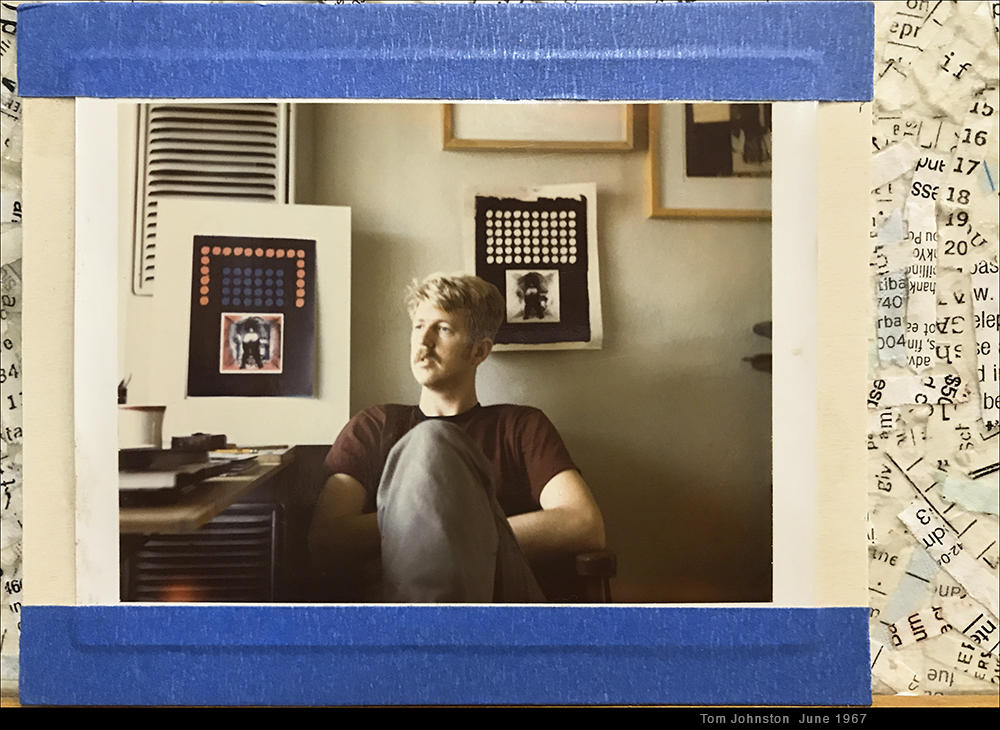 Yes, it was fifty years ago, if not on this exact day, it was in this month during June 1967 that this picture was taken.
Yes, it was fifty years ago, if not on this exact day, it was in this month during June 1967 that this picture was taken.
I had just made the lithograph shown in the photo, two states of its progress. It takes its title “Twentieth Century Fox with a Fantastic Plastic Four Speed Box” from a mash-up of music, pop, and car culture, and was the last print I made in California. It was hand drawn on stone, bleed printed with two transparent colors over black, on 15” x 11” Rives BFK in an edition of 20.
It is from a series of images investigating portrayals of women, based on lessons drawn from art history mixed with pop culture. As an artist I had been immersed in the history of art and had taken numerous life-drawing courses leading up to my MFA program in painting and printmaking. The topless dancer craze was in the initial stages of breaking into the mainstream world of entertainment. The quality of these presentations in California, from San Francisco to San Diego, saw a range from professional to low budget. The organizers were quick to capitalize on these floorshows and the controversy surrounding them met with successful commercialization early on.
Previous to this series I had been exploring sources of imagery, studying how images from art history could be mined and played against images in mass media. I was fascinated by daily images in the L.A. Times and national magazines. My study of the Italian Renaissance, coupled with inspiration by later artists such as Brueghel, Rembrandt, Goya, and in the 20th century Edvard Munch, Käthe Kollwitz and Picasso, showed me how art could offer a reflection of an artist’s personal life and a critique of their times. Drawing inspiration from daily experience and visiting California museums, SFMOMA, De Young, Santa Barbara Museum, LACMA, the former Pasadena and La Jolla Art museums and La Cienega galleries, all played an important role in my personal development as an artist.
There was always an exciting show to see in the museums and galleries: Marcel Duchamp, Pierre Bonnard, Pablo Picasso, Jasper Johns, Larry Rivers, and Ed Kienholz; and to name a few of the many California artists, some already recognized internationally and others poised to enter the national spotlight: John Baldessari, Richard Diebenkorn, Nathan Oliveira, Joan Brown, Peter Voulkos, Lynn Foulkes, Joe Goode, Ed Bereal, Ed Ruscha, Judy Gerowitz (Chicago), Betye Saar, Conner Everts, Ben Sakoguchi, Corita Kent, Ynez Johnston (no relation), John Altoon, Robert Irwin and Larry Bell.
In their roles as gallerists and curators, Walter Hopps, Irving Blum, Nick Wilder, Rolf Nelson, Henry T. Hopkins, Gerry Nordland, John Coplans, Thomas Leavitt, and Maurice Tuchman were creating first-rate programming. This was an exciting time to see and experience contemporary art by new artists engaged in a vital movement. Against this backdrop, I was a young artist, inspired by art of the past and fascinated by the variety of new art being made and presented on the west coast.
To conclude, I was curious about the presentation and spectacle, and witness to how the spectator could be both complicit and easily manipulated. I was drawing inspiration in this environment while attempting to offer a critique and create beautiful pictures. In the smaller clubs one could see the dancers as human beings and realize the complexities of their lives and personalities. In this series I wanted to draw on this spectacle and focus attention on the isolation, spatially and socially, of the woman in a box and consider how it continued the objectification. It was interesting to observe the audience, which included performers before and after their shift, and draw similarities to how Goya and Munch portrayed their times. Other works in this series turned the “spotlight” illuminating the dancer into the form of an inverted keyhole. Several of these works were included in print exhibitions in southern California and nationally. “Twentieth Century Fox…” was added to public and private collections.

What a good lookin guy…
Were we ever that young?
Ah, back in the day. That’s about when we met…